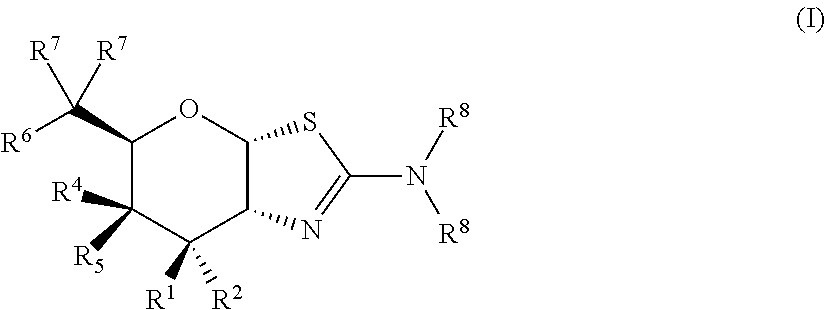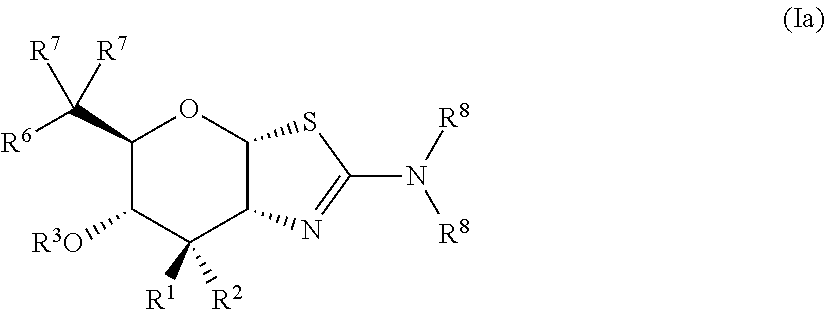Selective glycosidase inhibitors and uses thereof
a glycosidase inhibitor and selective technology, applied in the field of selective glycosidase inhibitors, can solve the problems of complex use of non-selective inhibitors in studying the physiological role of cellular and organismal enzymes, hyperphosphorylation of tau, and disruption of normal functions of tau, so as to achieve enhanced permeability
- Summary
- Abstract
- Description
- Claims
- Application Information
AI Technical Summary
Benefits of technology
Problems solved by technology
Method used
Image
Examples
example 1
(3aR,5R,6S,7R,7aR)-2-(ethylamino)-5-methyl-5,6,7,7a-tetrahydro-3aH-pyrano[3,2-d]thiazole-6,7-diol
[0172]
[0173]To a suspension of (3aR,5R,6S,7R,7aR)-2-(ethylamino)-5-(hydroxymethyl)-5,6,7,7a-tetrahydro-3aH-pyrano[3,2-d]thiazole-6,7-diol (35.0 g, 141 mmol) in DMF (300 mL) cooled at 15° C., was added DIPEA (6.0 mL), Boc2O (61.5 g, 282 mmol) and MeOH (6.0 mL). The mixture was stirred at room temperature for 16 h, and then MeOH (50 mL) was added. The reaction mixture was concentrated under reduced pressure at ˜35° C. The residue was purified on silica gel by flash column chromatography (EtOAc / hexanes 1:1, then MeOH / DCM, 1:5), followed by recrystallization from EtOAc / hexanes, to afford tert-butyl ((3aR,5R,6S,7R,7aR)-6,7-dihydroxy-5-(hydroxymethyl)-5,6,7,7a-tetrahydro-3aH-pyrano[3,2-d]thiazol-2-yl)(ethyl)carbamate as a white solid (31.5 g, 64% yield). 1H NMR (400 MHz, CDCl3) δ 6.12 (d, J=6.8 Hz, 1H), 4.23-4.22 (m, 114), 4.17-4.14 (m, 1H), 3.91-3.86 (m, 214), 3.81-3.77 (m, 3H), 3.59-3.55 (m,...
example 2
(3aR,5R,6S,7aR)-2-(ethylamino)-5-(hydroxymethyl)-5,6,7,7a-tetrahydro-3aH-pyrano[3,2-d]thiazol-6-ol
[0180]
[0181]To a solution of tert-butyl ((3 aR,5R,6S,7R,7aR)-6,7-dihydroxy-5-(hydroxymethyl)-5,6,7,7a-tetrahydro-3aH-pyrano[3,2-d]thiazol-2-yl)(ethyl)carbamate (1.64 g, 4.73 mmol), DIPEA (1.34 g, 10.4 mmol) and DMAP (0.010 g, 0.082 mmol) in DCM (50 mL), at 0° C., was added BzCl (1.33 g, 9.50 mmol) slowly. After addition the mixture was stirred at room temperature overnight. Satd. aqueous NH4Cl solution (50 mL) was added, and the organic layer was collected. The aqueous layer was further extracted with DCM (2×40 mL). The combined extract was dried over anhydrous Na2SO4. After filtration the solvent was evaporated under reduced pressure, and the residue was separated on silica gel by flash column chromatography (EtOAc / hexanes, 1:4 to 1:2), affording ((3aR,5R,6S,7R,7aR)-6-(benzoyloxy)-2-((tert-butoxycarbonyl)(ethyl)amino)-7-hydroxy-5,6,7,7a-tetrahydro-3aH-pyrano[3,2-d]thiazol-5-yl)methyl b...
example 3
(3aR,5R,6S,7aR)-5-(hydroxymethyl)-2-(methylamino)-5,6,7,7a-tetrahydro-3aH-pyrano[3,2-d]thiazol-6-ol
[0185]
[0186]To a suspension of (3aR,5R,6S,7R,7aR)-5-(hydroxymethyl)-2-(methylamino)-5,6,7,7a-tetrahydro-3aH-pyrano[3,2-d]thiazole-6,7-diol (1.50 g, 6.40 mmol) and NaHCO3 (1.01 g, 12.0 mmol) in THF / water (40 mL, 1:3) was added benzyl chloroformate (1.70 g, 10.0 mmol). The mixture was stirred at room temperature for 4 days. The organic solvent was removed under reduced pressure to result in a precipitate. The precipitated solid was collected by filtration, washed with Et2O and dried under vacuum, affording benzyl ((3aR,5R,6S,7R,7aR)-6,7-dihydroxy-5-(hydroxymethyl)-5,6,7,7a-tetrahydro-3aH-pyrano[3,2-d]thiazol-2-yl)(methyl)carbamate as a white solid (1.72 g, 73%). 1H NMR (400 MHz, CD3OD) δ 7.44-7.32 (m, 5H), 6.13 (d, J=6.9 Hz, 1H), 5.27-5.20 (m, 2H), 4.14 (t, J=6.1 Hz, 1H), 4.02 (t, J=4.9 Hz, 1H), 3.74 (dd, J=2.4, 12.0 Hz, 1H), 3.63 (dd, J=6.1, 12.0 Hz, 1H), 3.53 (dd, J=4.5, 9.2 Hz, 1H), 3...
PUM
| Property | Measurement | Unit |
|---|---|---|
| Volume | aaaaa | aaaaa |
| Volume | aaaaa | aaaaa |
| Molar density | aaaaa | aaaaa |
Abstract
Description
Claims
Application Information
 Login to View More
Login to View More - R&D
- Intellectual Property
- Life Sciences
- Materials
- Tech Scout
- Unparalleled Data Quality
- Higher Quality Content
- 60% Fewer Hallucinations
Browse by: Latest US Patents, China's latest patents, Technical Efficacy Thesaurus, Application Domain, Technology Topic, Popular Technical Reports.
© 2025 PatSnap. All rights reserved.Legal|Privacy policy|Modern Slavery Act Transparency Statement|Sitemap|About US| Contact US: help@patsnap.com



